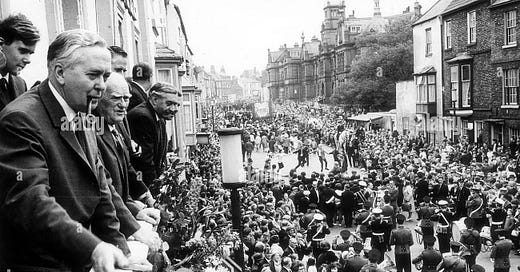Labour's loss in Durham is the end of a whole political tradition
This week's result was seismic
Probably more than any other city, Durham is the heartbeat of Labour’s traditions and links to working class Britain.
The picture above is of Harold Wilson and other members of his Cabinet on the balcony of the Royal County Hotel for Durham Miner’s Gala day. This was a day when Labour leaders would stand on the balcony before speaking to the assembled thousands at the nearby racecourse ground. For many years, I’d go to the Gala - just down the road from my home tow of Consett. I even wrote about it for Labour List here.
Each pit village would march from their village past the Royal County Hotel, with banners embodying the links between the villages, the chapel and Labour’s version of democratic socialism (more Labourism than Socialism, but that’s for another time).
The Durham Miners Won’t Wear It
I’m from a family who mined in the Durham and Northumberland coalfields and in the Consett steelworks, which was supplied by coal from the nearby pits. Even when I was growing up in Consett, there was still a sense that voting Labour and “being Labour” was something you did if you were from mining stock in this area.
A life down the mines was a dangerous job (my Grandad died a miner’s death of lung disease in his 50s). This danger, combined with tightly bonded communities, often bound around the pit, the chapel and the working man’s club, increased communal identity and identity with the Labour Party. As David Marquand put it, voting Labour in places like the Durham coalfield was as much cultural as it was political. the Labour Party was almost seen like an extended member of the family in many pit communities.
The quote that sums this up best is from Herbert Morrison, a titanic figure in the great figure of the 1945 Labour government. When that government was considering joining the European Coal and Steel Community, his response was, “the Durham miners won’t wear it” - emphasising the emotional centrality of the Durham coalfield to the Labour Party. A reminder that for the Labour movement, the Durham miners were “the aristocrats of the working class” - embodied in the extraordinary architecture of Miner’s Hall in Durham.
Long forgotten and ignored
The mines closed of course. As did the steelworks. And despite big promises, politicians of both parties failed to deliver jobs that brought the same pride and dignity as the ones that were lost. The old pit villages fell into decline, with social problems, health problems and addiction being rife. The social bonds that held these communities together went too. The chapels closed. The Miner’s Institutes closed. The cricket and football pitches paid for by the pit or steelworks fell into disrepair.
The heart of the Labour movement shifted from the working class towns and villages of the North of England to the big cities. The working class became less important in Parliament (as I warned in the Guardian over a decade ago) and in politics. Labour’s new base was that of middle class activists in the cities - less interested than their forebears in the Party at tackling class and regional inequality and more interested in critical theory and fashionable foreign struggles.
For years, these old pit villages in the Durham coalfield kept voting Labour. But it was more out of a sense of habit than any sense of emotional connection. The bond was slowly broken. While politicians talked about Britain booming, there was little that seemed to be booming in these pit villages, still struggling with the impact of Britain’s heavy handed deindustrialisation.
Little wonder, then, that after years of politicians ignoring them and Labour politicians taking their votes for granted, voters in these communities took advantage of the 2016 referendum to vote against the status quo and for radical change. All but one of the old coalfields voted for Brexit.
Big promises were made that better days would lie ahead, both in 2016 and by the Tories in 2019. But they were only words and they were quickly forgotten by those who uttered them. The pit villages continued falling behind. The grandchildren of the “aristocrats of the working class” treated with ill concealed snobbery by progressive politicians today.
Gradually, then suddenly
This is the backdrop for this week’s extraordinary result in Durham. This was a Council that Labour had run for over a century and on Thursday they found themselves wiped out. Reduced to a handful of Councillors after the “Turquoise Tsunami”. Nothing else embodies the Realignment as much as Labour being reduced to four Councillors in Durham.
For decades, Labour stopped trying to earn the votes of working class voters in Durham and years of neglect was punished in 2019. The Tories could have made headway, but they chose to fall back to their geographic and ideological comfort zone and they are now peering over the cliff at an uncertain future.
Reform will need to set out how they plan to deliver the kind of economic change to counties like Durham that the other parties have promised and failed to deliver. The status quo parties also need to make clear that they are serious about turning these “left behind communities around”.
At the moment, it’s worth noting, however that counties like Durham represent the reality of modern politics. A reality in which historic and tribal loyalties have been turned to rubble by decades of snobbery and neglect.
Labour losing Durham is more than just an election result. It represents the near extinction of a proud political tradition that once dominated both the heart and the head of the British Labour movement. It’s sad that it’s gone and even sadder that generations of Labour politicians were content to let it wither and die.







